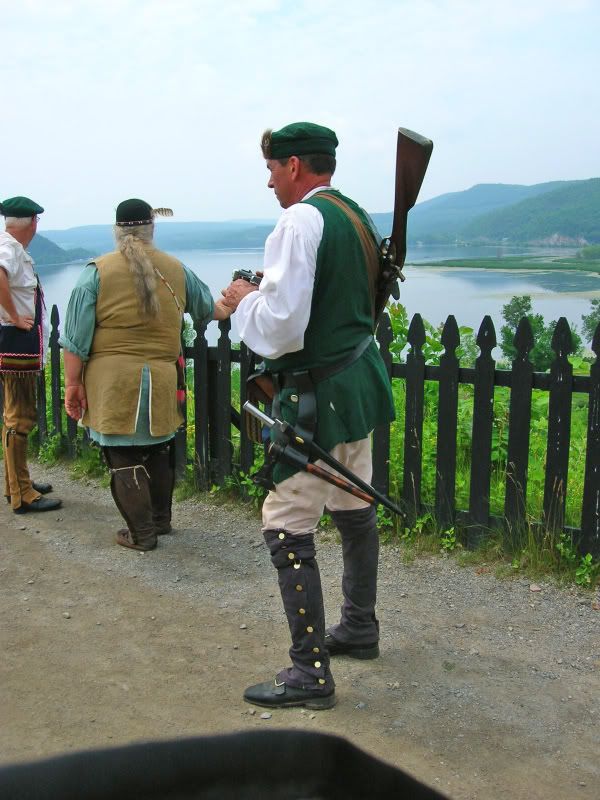There seems to be some confusion over what was done back in the heydey of Rogers' Rangers and the shortening of the muskets and darkening of barrels...,
"
Lord Howe . . . ordered the muskets to be shortened . . . the barrels of their guns were all blackened." MacVickers 1758
The queston then is how short were the muskets, and who carried them? This was the period when the Long Land Pattern musket was undergoing field modifications that led to the Short Land Pattern becoming the official "pattern".
"
The barrells of the Firelocks of the Light Infantry must all be made blue or brown, to take off the glittering." Moneypenny's Orderly Book, February 26, 1759.
So the light infantry, were modifying their muskets in the orderly's records. Did they cut them too? In the orderly's book does the term "light infantry" also mean rangers?

"
The companys to give in separate returns this evening, of the firelocks only, distinguishing between the sufficient and unsufficient, those cut or not cut". Orders to the 42nd Regiment of Highland Foote, 28 July 1761.
So here we see that the Black Watch may have had some "cut" firelocks, but how short?
Archaeological digs on Rogers' Island, Fort Edward, NY, did unearth what are believed to be cut off portions of musket barrles. However, the pieces found varied in length, from 4" to 8". Cutting off 4" of a 46" Long Land Pattern musket gives one a 42" barrel..., the length later settled on for the Short Land Pattern. AND..., there is no evidence that says the unearthed tubes were cut from the barrels of King's Muskets. They may be pieces from privately owned arms, or contract arms. Granted, those shortened by 8", IF they were Long Land Pattern muskets, would be considered very short at 38" barrels. However, we don't know that they weren't from 50" barreled fowlers, pirvately owned, and cut down to 42". The fact that the calibers when checked are not outside of those for a Long Lang Pattern musket is not proof the barrel pieces came from that sort of musket. :shocked2:
Some folks point to an order from Major Jeffery Amherst to Major Robert Rogers dated 25th May, 1760 "
You will take your men as light with you as possible, . . . let every man whose firelock will carry it have a bayonet." The implication is that some of the firelocks seem not to "carry" a bayonet, but that doesn't mean that those "firelocks" were cut down from British muskets, nor does the term "firelock" exclude rifles.
In support of the idea of private or contract guns, note that Lord Loudoun during the war authorized Rogers to form 5 new ranger companies, and and when doing so wrote"
to find their own arms, which must be fit, and be upon examination, shall be found fit, and be approved of." Which shows that the rangers did have contract muskets. So these may have had shortened barrels from day one, or the rangers shortened them while on Rogers' Island. Arms supplied from other sources other than The Crown were used by units other than the rangers..., Abercromby on March 15, 1758, wrote to several governors in colonies raising troops, and told them the troops needed to bring their own muskets.
In 1759, Rogers contracted with Greg & Cunningham to provide muskets (at least I think they were muskets) for his rangers. Rogers was informed on February 26th 1759,
"..., arms have been tried and proved by the artillery; they answer very well, and are ordered to be sent to you as fast as possible."
"Proved" by the artillery indicates the arms are new, the barrels not from England (for they would've been proofed prior to leaving the island), so had to be proofed in the colonies prior to acceptance.
So Rangers, some at least, probably had arms shorter than the standard Long Land Pattern bess..., but the evidence for the source of the shorter muskets is inconclusive (imho).
Conjecture:
I would think that without other evidence, shortening a King's Musket, AKA a Long Land Pattern musket to less than 42" highly unlikely a thing to be done in the 18th century, unless there was an actual order allowing it. True, their were Artillery Carbines in the same time period, and dragoon carbines, and NCO fusils, but from what I have seen these were made that way at the armory, not fashioned in provincial locations.
I think that Rogers could do whatever he wanted with contract arms of similar caliber to British muskets, but which were not made to the Board of Ordinance regulations, so he was not breaking regulations if they were made short or shortened after arrival.
As for accuracy, it is well known that when properly loaded, and used by a person who has practised often with a specific musket, that they are indeed quite accurate out to nearly 100 yards. (The 3rd model/East India Company Pattern Bess with barrels of about 38" did quite well.) Plus, annecdotal accounts of shooting pine cones does not include an account limiting the rangers to using a single ball does it? We know from Knox' Journal (iirc) the Rangers carried "pea sized" shot as well, and they could've been using that to shoot the cones. (Shooting cones with shot does give a rather satisfying "explosion" of the cone when the cone is hit.)
LD






